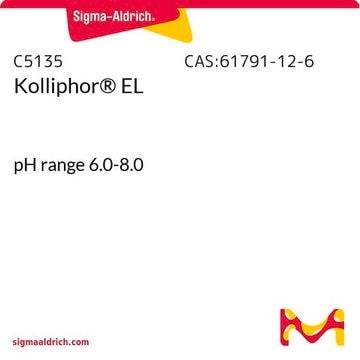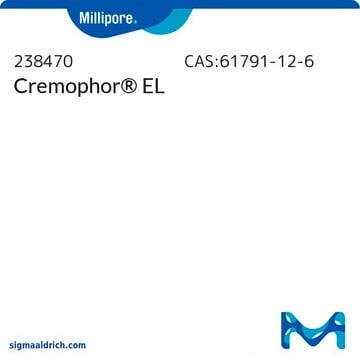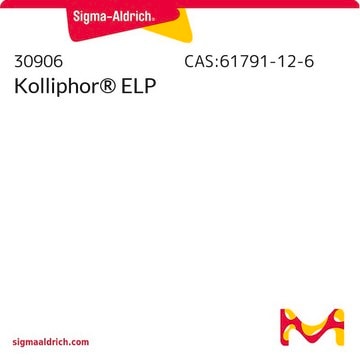Products may be shipped at a different temperature than the recommended long-term storage temperature. If the product quality is sensitive to short-term exposure to conditions other than the recommended long-term storage, it will be shipped on wet or dry-ice. If the product quality is NOT affected by short-term exposure to conditions other than the recommended long-term storage, it will be shipped at ambient temperature. As shipping routes are configured for minimum transit times, shipping at ambient temperature helps control shipping costs for our customers. For more information, please refer to the Storage and Transport Conditions document: https://www.sigmaaldrich.com/deepweb/assets/sigmaaldrich/marketing/global/documents/316/622/storage-transport-conditions-mk.pdf
32211
Chloroform
puriss. p.a., reag. ISO, reag. Ph. Eur., 99.0-99.4% (GC)
Synonym(s):
Methylidyne trichloride, Trichloromethane
About This Item
Recommended Products
Agency
USP/NF
reag. ISO
reag. Ph. Eur.
Quality Level
vapor density
4.1 (vs air)
vapor pressure
160 mmHg ( 20 °C)
grade
puriss. p.a.
Assay
99.0-99.4% (GC)
form
liquid
contains
~1% ethanol as stabilizer
technique(s)
RNA extraction: suitable
impurities
≤0.00001% free chlorine (Cl)
≤0.00005% free acid (as HCl)
≤0.0005% non-volatile matter
≤0.005% aldehydes and ketones (as CH3COCH3)
≤0.005% carbonyl compounds (as CO)
≤0.01% tetrachloroethene (GC)
≤0.01% tetrachloromethane (GC)
≤0.01% trichloroethene (GC)
≤0.01% water (Karl Fischer)
≤0.03% dichloromethane (GC)
0.6-1.0% ethanol (GC)
refractive index
n20/D 1.445 (lit.)
bp
60.5-61.5 °C (lit.)
mp
−63 °C (lit.)
density
1.476-1.483 g/mL at 20 °C
1.492 g/mL at 25 °C (lit.)
anion traces
chloride (Cl-): ≤1 mg/kg
cation traces
Al: ≤0.5 mg/kg
B: ≤0.02 mg/kg
Ba: ≤0.1 mg/kg
Ca: ≤0.5 mg/kg
Cd: ≤0.05 mg/kg
Co: ≤0.02 mg/kg
Cr: ≤0.02 mg/kg
Cu: ≤0.02 mg/kg
Fe: ≤0.1 mg/kg
Mg: ≤0.1 mg/kg
Mn: ≤0.02 mg/kg
Ni: ≤0.02 mg/kg
Pb: ≤0.05 mg/kg
Sn: ≤0.1 mg/kg
Zn: ≤0.1 mg/kg
SMILES string
ClC(Cl)Cl
suitability
complies for appearance
complies for reaction against H2SO4
complies for suitability of determ. w. dithizone
InChI
1S/CHCl3/c2-1(3)4/h1H
InChI key
HEDRZPFGACZZDS-UHFFFAOYSA-N
Looking for similar products? Visit Product Comparison Guide
Related Categories
General description
Application
- Extraction of RNA from plant cells.[2]
- Preparation of dioleoylphosphatidylcholine (DOPC) solution.[3]
- Dissolution of 1,2-distearoyl-sn-glycero-3-phosphocholine (DSPC).[4]
Other Notes
Chloroform Miscibility/Immiscibility Table
The article number 32211-4X2.5L-M will be discontinued. Please order the single bottle 32211-2.5L-M which is physically identical with the same exact specifications.
The article number 32211-6X1L will be discontinued. Please order the single bottle 32211-1L which is physically identical with the same exact specifications.
The article number 32211-6X1L-M will be discontinued. Please order the single bottle 32211-1L-M which is physically identical with the same exact specifications.
Signal Word
Danger
Hazard Statements
Precautionary Statements
Hazard Classifications
Acute Tox. 3 Inhalation - Acute Tox. 4 Oral - Carc. 2 - Eye Irrit. 2 - Repr. 2 - Skin Irrit. 2 - STOT RE 1 Oral - STOT SE 3
Target Organs
Central nervous system, Liver,Kidney
Storage Class Code
6.1D - Non-combustible acute toxic Cat.3 / toxic hazardous materials or hazardous materials causing chronic effects
WGK
WGK 3
Flash Point(F)
does not flash
Flash Point(C)
does not flash
Choose from one of the most recent versions:
Already Own This Product?
Find documentation for the products that you have recently purchased in the Document Library.
Customers Also Viewed
-
How is shipping temperature determined? And how is it related to the product storage temperature?
1 answer-
Helpful?
-
-
How can I determine the shelf life / expiration / retest date of this product?
1 answer-
If this product has an expiration or retest date, it will be shown on the Certificate of Analysis (COA, CofA). If there is no retest or expiration date listed on the product's COA, we do not have suitable stability data to determine a shelf life. For these products, the only date on the COA will be the release date; a retest, expiration, or use-by-date will not be displayed.
For all products, we recommend handling per defined conditions as printed in our product literature and website product descriptions. We recommend that products should be routinely inspected by customers to ensure they perform as expected.
For products without retest or expiration dates, our standard warranty of 1 year from the date of shipment is applicable.
For more information, please refer to the Product Dating Information document: https://www.sigmaaldrich.com/deepweb/assets/sigmaaldrich/marketing/global/documents/449/386/product-dating-information-mk.pdfHelpful?
-
Active Filters
Our team of scientists has experience in all areas of research including Life Science, Material Science, Chemical Synthesis, Chromatography, Analytical and many others.
Contact Technical Service










